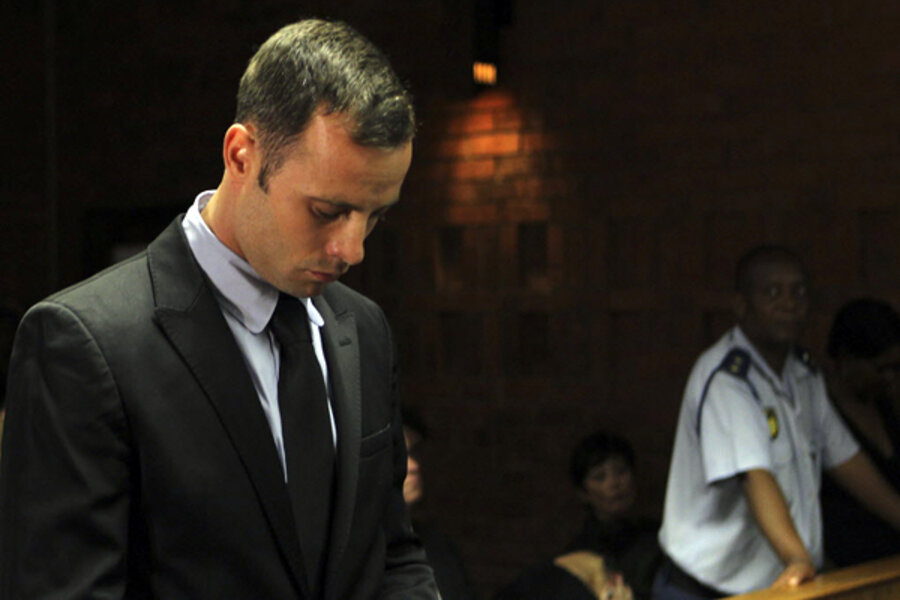Oscar Pistorius trial: Is it South Africa's version of the OJ Simpson trial?
Loading...
| Johannesburg, South Africa
The court case of Olympian and double-amputee Oscar Pistorius, accused of shooting and killing his model girlfriend Reeva Steenkamp early Valentine’s Day morning, is still in early stages. But the fame of the accused and the media frenzy surrounding the bail hearing today has many dubbing it “South Africa’s OJ Simpson trial.”
The media were immediately aflame with reports of the killing inside Mr. Pistorius’s house, located in an exclusive, high-security housing community. And South Africa has since seemed to have spoken of little other than the “Blade Runner” – so named for the high-tech carbon-fiber prosthetic legs he uses when competing.
The instant infamy of the case recalled for some in South Africa the “Trial of the Century” in the US when Mr. Simpson, a former football star, was accused of killing his wife. His trial almost two decades ago riveted America for months.
One commentator on the SABC, the South African public broadcaster, argued that the South African case could be even bigger, as Pistorius was already world-famous while Simpson, who broke records in American football and was well known in the US, only gained global infamy after his criminal trial.
“It’s an obvious comparison, but we're at an early stage. I mean, are South Africans as interested in the minutiae of the story as the OJ case? Yes, possibly,” says Indra de Lanerolle of the University of Witwatersrand’s Journalism department.
The killing comes six months after Pistorius returned home to a hero’s welcome following his success in the 2012 London Olympics and Paralympics. One local magazine featured him on their cover with the headline “Man of the Future.”
Pistorius claimed that he mistook his girlfriend for an intruder behind a bathroom door and, not realizing that Ms. Steenkamp was not in bed, opened fire with a licensed 9 mm he took from under his pillow.
But details quickly emerged that neighbors complained of shouting from the house leading up to the shooting, and police officials said they had been called to the Pistorius home for “previous incidents of a domestic nature.”
Media circus
Outside the Pretoria courthouse Tuesday, before his bail hearing started, television news trucks from both local and international media outlets set up shop while journalists battled to get inside.
An image that captures the media frenzy is a widely circulated video of Pistorius standing alone before the court, while more than a dozen photographers stand close by, cameras pointing at him, clicking away madly.
Already, Sunday papers had been filled with opinions and columns and articles tackling the story from every angle. Journalists cited anonymous sources detailing the crime scene, reporting that Steenkamp was shot multiple times. Local weekly City Press created an elaborate graphic to describe how authorities believe the killing unfolded.
The Pistorius defense team responded, criticizing the investigation, arguing that it had not yet even been given access to the crime scene to conduct their own investigation — and appeared to be working to cast popular doubt about the state’s case against their client.
The glove, the cricket bat
In what hearkens back to Simpson’s iconic bloody glove — a bloody cricket bat found at the crime scene was the topic of discussion in many articles.
Also similar is the status of the lawyers involved: Well-known criminal defense lawyer Barry Roux will represent Pistorius. The even more famous Gerrie Nel — who successfully prosecuted South Africa’s former police chief for corruption — will lead the prosecution.
As the media has scrambled for access or any details of the case in an effort to feed the insatiable public appetite for details, there remains a major difference between the two trials: the existence of social media. The constant tweeting has given South Africa’s growing social media public unprecedented access to the Pistorius trial where live television coverage is forbidden.
Journalists inside the courtroom have competed to tweet as often as possible, giving their followers up to the second, play-by-play of the proceedings.
“I had to turn off half the journalists I follow because of the volume,” said Mr. de Lanerolle. “It was 20 or 30 tweets an hour. It's almost like live TV.”
Because of wide disparities between rich and poor in South Africa, only a minority have Internet access. However, among those that do, Twitter is enormously popular.
Technology research company WorldWideWorx found that Twitter was the fastest growing social networking site in South Africa, with 1.1 million users in mid-2011, a 20-fold increase from the previous year.
“I think the thing about Twitter in South Africa is that it’s very popular out of the community of Internet users,” says de Lanerolle. “It really picked up especially among journalists, so it has a very strong news bent.”







